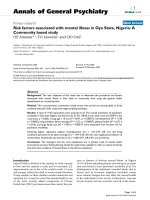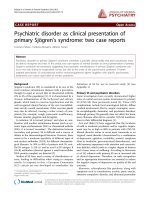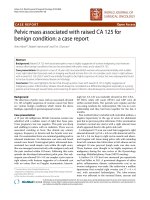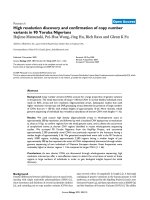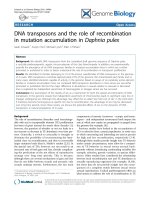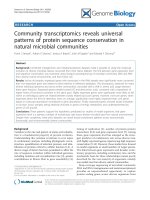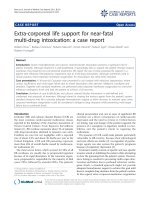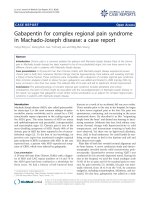Báo cáo y học: "Umbilical hernia rupture with evisceration of omentum from massive ascites: a case report" pdf
Bạn đang xem bản rút gọn của tài liệu. Xem và tải ngay bản đầy đủ của tài liệu tại đây (1.23 MB, 3 trang )
CAS E REP O R T Open Access
Umbilical hernia rupture with evisceration of
omentum from massive ascites: a case report
Daniel W Good
*
, Jonathan E Royds, Myles J Smith, Paul C Neary and Emmanuel Eguare
Abstract
Introduction: The incidence of hernias is increased in patients with alcoholic liver disease with ascites. To the best
of our knowledge, this is the first report of an acute rise in intra-abdominal pressure from straining for stool as the
cause of a ruptured umbilical hernia.
Case presentation: An 81-year-old Caucasian man with a history of alcoholic liver disease presented to our
emergency department with an erythematous umbilical hernia and clear, yellow discharge from the umbilicus. On
straining for stool, after initial clinical assessment, our patient noted a gush of fluid and evisceration of omentum
from the umbilical hernia. An urgent laparotomy was performed with excision of the umbilicus and devitalized
omentum.
Conclusion: We report the case of a patient with a history of alcoholic liver disease with ascites. Ascites causes a
chronic increase in intra-abdominal pressure. A sudden increase in intra-abdominal pressure, such as coughing,
vomiting, gastroscopy or, as in this case, straining for stool can cause rupture of an umbilical hernia. The presence
of discoloration, ulceration or a rapid increase in size of the umbilical hernia signals impending rupture and should
prompt the physician to reduce the intra-abdominal pressure.
Introduction
The anterior abdominal wall has multiple areas of
potential weakness (deep and superficial inguinal rings,
Hesselbach’ s trian gle, the fem oral ring an d so on)
which, when exposed to acute or chronically elevated
intra-abdominal pressure, are prone to weaken and
allow the formation o f various hernias [1]. The umbili-
cus is one of these areas of potential weakness as it
interrupts the continuity of the linea alba [1].
Intra-abdominal pressure varies in both an acute and a
chronic manner. During normal physiology acute varia-
tions in intra-abdominal pressure mainly follow changes
in body position and patient activities [2-4]. In health
subjects, causes of chronic increases in intra-abdominal
pressure include obesity, visce romegaly and pregna ncy
[5,6]. Intra-abdominal pressure is also chronically ele-
vated in various disease processes including ascites,
large cysts and large neoplastic formations [7-9] which
increase the likelihood of hernias.
Case Presentation
An 81-year-old Caucasian man, with a background
history of alcoholic liver disease, presented acutely via our
emergency department, with an erythematous umbilical
hernia and clear, yellow discharge from the umbilicus.
Clinical examination showed signs of decompensated liver
disease, including asterixis, spider naevi, a distended abdo-
men with s hifting dullness, fluid thrill and an erythema-
tous umbilical hernia. On straining for stool, after initial
clinical assessment, our patient noted a gu sh of fluid and
evisceration of omentum from the umbilical hernia
(Figures 1 and 2).
An urgent laparotomy was performed, using povidone-
iodine solution for skin preparation via a midline inci-
sion, with excision of the umbilicus and devitalized
omentum. Of note, there was evidence of recanalization
of the umbilical vein. A full examination of the abdom-
inal viscera was performed, and samples of ascitic f luid
sent for cytological, biochemical and microbiological
analysis. The liver was noted to be nodular, shrunken
and sclerotic with generalized fibrinous exudate lining
the coelomic cavity. His post-operative a-fetoprotei n
was 798 IU/mL. The abdominal fascial edges were
* Correspondence:
Minimally Invasive Surgical Unit, Division of Colorectal Surgery, AMNCH,
Tallaght, Dublin 24, Ireland
Good et al. Journal of Medical Case Reports 2011, 5:170
/>JOURNAL OF MEDICAL
CASE REPORTS
© 2011 Good et al ; licensee Bio Med Central Ltd. This is an Open Access article distribute d under the terms of the Creative Co mmons
Attribution License ( s/by/2.0), which permits unres tricted use, distribution, and reproduction in
any medium, provided the original work is properly cited.
re-apposed with interrupted 1/0 polypropylene sutures,
withclipstotheskin.Theascitic fluid serum-ascites
albumin gradient was >1.1 g/dL, and showed increased
ascitic protein level (>2.5 g/dl). Cytology was negative
for malignant cells.
Discussion
The incidence of hernias is increased in patients with
alcoholic liver disease with ascites [10]. The first
reported case of spontaneous rupture of an umbilical
hernia from ascites was reported by Mixter in 1901 [11].
The precipitating factors for rupture described include
local trauma and a sudden increase in intra-abdominal
pressure, such as coughing, vomiting or esophagoscopy.
To the best of our knowledge, straining for stool has
not yet been reported in the literature as a cause of
acute rupture of an umbilical hernia. All of the above
precipitants are known to cause acute variations in the
intra-abdomi nal pressure [3,4]. In the presence of
chronic elevation of intra-abdominal pressure, such as
occurs with ascites, these activities and patient positions
cause an addition al increase in intra-abdominal pressure
which can overwhelm the strength of the anterior
abdominal wall layers [12]. The presence of discoloura-
tion, ulceration or a rapid increase in size of the umbili-
cal hernia signals impending rupture [13].
Current thinking suggests that there is a dynamic
adaptive change which takes place in all organisms in
response to a chronically elevated intra-abdominal pres-
sure, principally as adaptations to the constitutional
properti es of the abdominal cavity. This occurs in order
to maintain normal functioning [7,14-16]. These adapta-
tions are mainly in the form of changes in muscular
structures. There have been several animal studies
showing that muscular components of the abdominal
cavity, as well as the diaphragm, adapt when subjected
to conditions of increasing intra- abdominal pressure
[7,17]. However, it is likely that in more acute or sub-
acute changes of intra-abdominal pressure, such as a
sudden increase in ascites combined with s training for
stoolasinthiscasereport,itmayovercometheelasti-
city of the abdominal wall and lead to hernias or worse
hernia rupture.
Conclusion
There has been considerable debate in the literature as
to the tim ing of umbilical hernia repair in patients
with alcoholic liver disease and ascites. Older studies,
in particular by Baron [18], described poor outcomes
in electi ve repair with mort ality rates of up to 38%.
Some of the poor outcome was thought to involve a
disruption of portal venous flow around the umbilicus,
causing increased portal pressure which may lead to
variceal bleeding. Other studies [19,20] have shown
improved outcomes in the elective setting but require
intensive pre-operative optimization. Some experts [21]
would operate in the elective setting for Child’sAcir-
rhosis and when complications of umbilical hernias
develop an urgent r epair is indicated. Current litera-
ture suggests that control of ascites post-operatively is
critical to prevent recurrence [22]. There are several
possible techniques such as trans-jugular intra-hepatic
portosystemic stent-shunts, peritoneovenous shunt or
percutaneous peritoneal drainage catheters, however
thereisinsufficientevidencetoproposeoneoverany
other [21]. The same is true for choosing between the
use of mesh, primary closure, and even fibrin glue, all
of which have been used in various studies. The use of
fibrin glue is currently restricted to patients declared
unfit/unwilling to undergo operative repair [23]. A
recent expert consensus study suggested a decrease in
the suitability of mesh repair as the Child’ sscore
increases [21].
Figure 1 Side on view of distended abdomen with an umbilical
hernia with evisceration of omentum.
Figure 2 Vertical view of distended abdomen with rupture of
the umbilical hernia with evisceration of omentum.
Good et al. Journal of Medical Case Reports 2011, 5:170
/>Page 2 of 3
Ultimately, more evidence is required, and cases
should be considered individually, to determine the
most effective timing of umbilical hernia repair.
Consent
Written informed consent was obtained from the patient
for publicatio n of this case report and any accompany-
ing images. A copy of the written consent is avail able
for review by the Editor-in-Chief of this journal.
Authors’ contributions
DWG conceived the manuscript, collected the data, took the photographs,
wrote and revised the manuscript. JER collected data and reviewed the
manuscript. MS conceived and reviewed the manuscript. PCN wrote the
manuscript and performed a final review. EE performed a final review. All
authors read and approved the final manuscript.
Competing interests
The authors declare that they have no competing interests.
Received: 7 October 2010 Accepted: 3 May 2011 Published: 3 May 2011
References
1. Russel RCG, Williams NS, Bulstrode CJK, (eds.): Bailey & Love’s Short Practise
of Surgery. 25 edition. Hodder Arnold; 2008.
2. Park CK: The effect of patient positioning on intraabdominal pressure
and blood loss in spinal surgery. Anesth Analg 2000, 91(3):552-557.
3. Cobb WS, Burns JM, Kercher KW, Matthews BD, Norton H, Heniford BT:
Normal Intra abdominal Pressure in healthy adults. J Surg Res 2005,
129:231-235.
4. Iqbal A, Stadlhuber RJ, Karu A, Corkill S, Filipi CJ: A study of intragastric
and intravesicular pressure changes during rest, coughing, weight
lifting, retching and vomiting. Surg Endosc 2008, 22(12):2571-2575.
5. Sugerman H, Windsor A, Bessos M, Wolfe L: Intra-abdominal pressure,
saggital abdominal diameter and obesity comorbidity. J Intern Med 1997,
241(1):71-79.
6. Twardowski ZJ, Tully RJ, Ersoy FF, Dedhia NM: Computerized tomography
with and without intraperitoneal contrast for determination of
intraabdominal fluid distribution and diagnosis of complications in
peritoneal dialysis patients. ASAIO Trans 1990, 36(2):95-103.
7. Papavramidis TS, Duros V, Michalopoulos A, Papadopoulos VN,
Paramythiotis D, Harladtis N: Intra-abdominal pressure alterations after
large pseudocyst transcutaneous drainage. BMC Gastroenterol 2009,
9:42-46.
8. Bastani B, Dehdashti F: Hepatic hydatid disease in Iran, with review of the
literature. Mt Sinai J Med 1992, 62(1):62-69.
9. Chao A, Chao A, Yen YS, Huang CH: Abdominal compartment syndrome
secondary to ovarian mucinous cystadenoma. Obstet Gynecol 2004, 104(5
Pt 2):1180-1182.
10. Chapman CB, Snell AM, Roundtree LG: Decompensated portal cirrhosis.
JAMA 1931, 97:237-244.
11. Johnnson JT: Ruptured umbilical hernia. Trans South Surg Assoc 1901,
14:257-268.
12. Guttormson R, Tschirhart J, Boysen D, Martinson K: Are postoperative
activity restrictions evidence-based? Am J Surg 2008, 195(3):401-403.
13. Lemmer JH, Strodel WE, Knol JA, Eckhauser FE: Management of
spontaneous umbilical hernia disruption in the cirrhotic patient. Ann
Surg 1983, 198(1):30-34.
14. Lalatta Costerbosa G, Barazzoni AM, Lucchi ML, Bortolami R: Histochemical
types and sizes of fibres in the rectus abdominis muscle of guinea pig:
adaptive response to pregnancy. Anat Rec 1987, 217(1):23-29.
15. Prezant DJ, Aldrich TK, Karpel JP, Lynn RI: Adaptation in the diaphragm
’s
in vitro force-length relationship in patients on continuous ambulatory
peritoneal dialysis. Am Rev Respir Dis 1990, 141(5 Pt 1):1342-1349.
16. Gilleard WL, Brown JM: Structure and function of the abdominal muscles
in primigravid subjects during pregnancy and the immediate postbirth
period. Phys Ther 1996, 76(7) :750-762.
17. Kotidis EV, Papavramidis TS, Ioannidis K, Cheva A, Lazou T, Michalopoulos N,
Karkavelas G, Papavramidis ST: The effect of chronically increased intra-
abdomial pressure on rectus abdominis muscle histology an
experimental study on rabbits. J Surg Res 2010.
18. Baron HC: Umbilical hernia secondary to cirrhosis of the liver. N Engl J
Med 1960, 263:824-828.
19. O’Hara ET, Oliai A, Patek AJ Jr, Nabseth DC: Management of umbilical
hernia associated with hepatic cirrhosis and ascites. Ann Surg 1973,
181(1):85-87.
20. Granese J, Valaulikar G, Khan M, Hardy H: Ruptured umbilical hernia in a
case of alcoholic cirrhosis with massive ascites. Am Surg 2002,
68(8):733-734.
21. McKay A, Dixon E, Bathe O, Sutherland F: Umbilical hernia repair in the
presence of cirrhosis and ascites: results of a survey and review of the
literature. Hernia 2009, 13(5):461-468.
22. Belghiti J, Durand F: Abdominal wall hernias in the setting of cirrhosis.
Semin Liver Dis 1997, 17(3):219-226.
23. Melcher ML, Lobato RL, Wren SM: A Novel Technique to Treat Ruptured
Umbilical Hernias in Patients with Liver Cirrhosis and Severe Ascites.
J Laparoendosc Adv Surg Tech A 2003, 13(5):331-332.
doi:10.1186/1752-1947-5-170
Cite this article as: Good et al.: Umbilical hernia ruptu re with
evisceration of omentum from massive ascites: a case report. Journal of
Medical Case Reports 2011 5:170.
Submit your next manuscript to BioMed Central
and take full advantage of:
• Convenient online submission
• Thorough peer review
• No space constraints or color figure charges
• Immediate publication on acceptance
• Inclusion in PubMed, CAS, Scopus and Google Scholar
• Research which is freely available for redistribution
Submit your manuscript at
www.biomedcentral.com/submit
Good et al. Journal of Medical Case Reports 2011, 5:170
/>Page 3 of 3
